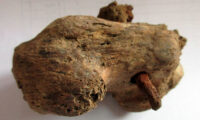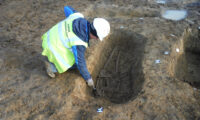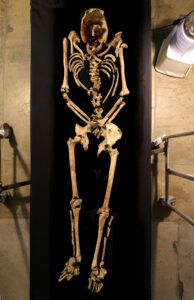 Archaeologists have discovered the remains of a man with a nail driven through his heel that is the first evidence of Roman crucifixion found in Britain. It is the first physical evidence of Roman crucifixion found in northern Europe, for that matter, and only the second example with the nail that was driven through it still piercing the bone.
Archaeologists have discovered the remains of a man with a nail driven through his heel that is the first evidence of Roman crucifixion found in Britain. It is the first physical evidence of Roman crucifixion found in northern Europe, for that matter, and only the second example with the nail that was driven through it still piercing the bone.
The skeleton of the crucified man was one of many burials unearthed at Fenstanton in the Cambridgeshire fens in excavations between 2016 and 2018. Fenstanton was on the Via Devana, the Roman road linking Cambridge to Godmanchester, and a few remains of a Roman villa and settlement have been found in the northern perimeter of the town. The southern edge of town was excavated for the first time in 2016 before construction of a housing development. Those exploratory trenches revealed evidence (coins, pottery, animal bones) of a Roman settlement from the late 1st or early 2nd century that was more populous and larger than previously realized. County officials worked with the developers to revised the plans to allow for additional excavation and keeping the best-preserved archaeological remains in situ.
 Contractors Albion Archaeology returned to the site in 2017 to excavate it fully. A 2018 excavation expanded at the site of a former bottling plant across the street. Over the two sites, archaeologists identified five small cemeteries and a few individual burials totaling 48 individuals. A smattering of grave goods, pottery and animal bones date almost all of the burials to the 4th century A.D.
Contractors Albion Archaeology returned to the site in 2017 to excavate it fully. A 2018 excavation expanded at the site of a former bottling plant across the street. Over the two sites, archaeologists identified five small cemeteries and a few individual burials totaling 48 individuals. A smattering of grave goods, pottery and animal bones date almost all of the burials to the 4th century A.D.
Skeleton 4926 was found in the 2017 excavation, one of a group of seven closely spaced burials in Cemetery D. He was an adult male between 25 and 35 years old at time of death. Radiocarbon analysis dated the bones to 130-340 A.D. His body was in supine position with his arms bent and hands crossed over the pelvis. The skeleton was surrounded by a dozen iron nails, not in the rectangular shape you’d expect if they had been coffin nails. There were traces of oak on some of the nails, however, so wood construction was involved, perhaps a bier.
 His difficult life was writ on his bones. He suffered extensive tooth decay — cavities, abscesses, tooth loss in childhood and shortly before death — severe gum recession and a pitted palate probably caused by infection. He was malnourished in childhood and already had arthritis in his spine. There was an indentation on his left fibula, possibly caused by an old fracture, and the tibiae and fibulae of both legs were thinned from either infection/inflammation or constant irritation from being bound or shackled.
His difficult life was writ on his bones. He suffered extensive tooth decay — cavities, abscesses, tooth loss in childhood and shortly before death — severe gum recession and a pitted palate probably caused by infection. He was malnourished in childhood and already had arthritis in his spine. There was an indentation on his left fibula, possibly caused by an old fracture, and the tibiae and fibulae of both legs were thinned from either infection/inflammation or constant irritation from being bound or shackled.
The archaeological team didn’t realize there was something special about this skeleton until his bagged and tagged bones were being cleaned in the laboratory. That’s where a 13th iron nail was found, only this one was driven through his right heel bone horizontally. The only other known example of a calcaneus with a nail through it was found in Israel in 1968. It was in an ossuary inscribed with his name: Yehohanan, son of Hagakol. The nail in Yehohanan’s heel was in the same horizontal position as the Fenstanton man’s.
David Ingham, project manager at Albion Archaeology, which conducted the dig, said: “Well it’s the first time a skeleton has been excavated archaeologically that anyone has found a nail in, so it’s not the sort of thing you’re looking for.”
He went on: “We know a reasonable amount about crucifixion; how it was practised and where it was practised and when and so on from historical accounts. But it’s the first tangible evidence to actually see how it worked.”
The off-site analysis was conducted by Corinne Duhig, a renowned archaeologist at the University of Cambridge, who came to the conclusion that crucifixion was the reason the nail was used.
The find is more remarkable because it is highly unusual for the body of a crucifixion victim to be reclaimed, brought back to a settlement and buried alongside others.
A report on the excavation and discovery of the crucifixion victim has been published in British Archaeology Magazine and can be read in its entirety here (pdf).